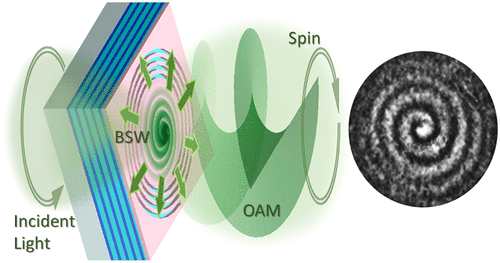当前位置:
X-MOL 学术
›
ACS Photonics
›
论文详情
Our official English website, www.x-mol.net, welcomes your feedback! (Note: you will need to create a separate account there.)
Vortex Beam Generation by Spin-Orbit Interaction with Bloch Surface Waves
ACS Photonics ( IF 7 ) Pub Date : 2020-02-20 , DOI: 10.1021/acsphotonics.9b01625 Ugo Stella 1 , Thierry Grosjean 2 , Natascia De Leo 3 , Luca Boarino 3 , Peter Munzert 4 , Joseph R. Lakowicz 5 , Emiliano Descrovi 1
ACS Photonics ( IF 7 ) Pub Date : 2020-02-20 , DOI: 10.1021/acsphotonics.9b01625 Ugo Stella 1 , Thierry Grosjean 2 , Natascia De Leo 3 , Luca Boarino 3 , Peter Munzert 4 , Joseph R. Lakowicz 5 , Emiliano Descrovi 1
Affiliation

|
Axis-symmetric grooves milled in metallic slabs have been demonstrated to promote the transfer of Orbital Angular Momentum (OAM) from far- to near-field and vice versa, thanks to spin-orbit coupling effects involving Surface Plasmons (SP). However, the high absorption losses and the polarization constraints, which are intrinsic in plasmonic structures, limit their effectiveness for applications in the visible spectrum, particularly if emitters located in close proximity to the metallic surface are concerned. Here, an alternative mechanism for vortex beam generation is presented, wherein a free-space radiation possessing OAM is obtained by diffraction of Bloch Surface Waves (BSWs) on a dielectric multilayer. A circularly polarized laser beam is tightly focused on the multilayer surface by means of an immersion optics, such that TE-polarized BSWs are launched radially from the focused spot. While propagating on the multilayer surface, BSWs exhibit a spiral-like wavefront due to the Spin-Orbit Interaction (SOI). A spiral grating surrounding the illumination area provides for the BSW diffraction out-of-plane and imparts an additional azimuthal geometric phase distribution defined by the topological charge of the spiral structure. At infinity, the constructive interference results into free-space beams with defined combinations of polarization and OAM satisfying the conservation of the Total Angular Momentum, based on the incident polarization handedness and the spiral grating topological charge. As an extension of this concept, chiral diffractive structures for BSWs can be used in combination with surface cavities hosting light sources therein.
中文翻译:

通过自旋轨道与Bloch面波相互作用产生涡旋光束
由于涉及表面等离激元(SP)的自旋轨道耦合效应,已证明在金属平板上铣制的轴对称凹槽可促进轨道角动量(OAM)从远场转移到近场,反之亦然。但是,等离子激元结构中固有的高吸收损耗和偏振约束限制了它们在可见光谱中的应用效率,特别是如果考虑到紧邻金属表面的发射器。在这里,提出了一种产生涡流束的替代机制,其中具有OAM的自由空间辐射是通过在电介质多层板上衍射Bloch表面波(BSW)获得的。圆偏振激光束通过浸没光学器件紧紧聚焦在多层表面上,这样,TE极化的BSW从聚焦点径向发射。当在多层表面上传播时,由于自旋轨道相互作用(SOI),BSW呈现出螺旋状的波前。围绕照明区域的螺旋光栅提供BSW平面外衍射,并赋予由螺旋结构的拓扑电荷定义的附加方位角几何相位分布。在无限远处,基于入射的偏振惯性和螺旋光栅的拓扑电荷,相长干涉将导致自由空间束具有定义的偏振和OAM组合,满足总角动量守恒。作为该概念的扩展,可以将用于BSW的手性衍射结构与其中容纳光源的表面腔结合使用。
更新日期:2020-02-21
中文翻译:

通过自旋轨道与Bloch面波相互作用产生涡旋光束
由于涉及表面等离激元(SP)的自旋轨道耦合效应,已证明在金属平板上铣制的轴对称凹槽可促进轨道角动量(OAM)从远场转移到近场,反之亦然。但是,等离子激元结构中固有的高吸收损耗和偏振约束限制了它们在可见光谱中的应用效率,特别是如果考虑到紧邻金属表面的发射器。在这里,提出了一种产生涡流束的替代机制,其中具有OAM的自由空间辐射是通过在电介质多层板上衍射Bloch表面波(BSW)获得的。圆偏振激光束通过浸没光学器件紧紧聚焦在多层表面上,这样,TE极化的BSW从聚焦点径向发射。当在多层表面上传播时,由于自旋轨道相互作用(SOI),BSW呈现出螺旋状的波前。围绕照明区域的螺旋光栅提供BSW平面外衍射,并赋予由螺旋结构的拓扑电荷定义的附加方位角几何相位分布。在无限远处,基于入射的偏振惯性和螺旋光栅的拓扑电荷,相长干涉将导致自由空间束具有定义的偏振和OAM组合,满足总角动量守恒。作为该概念的扩展,可以将用于BSW的手性衍射结构与其中容纳光源的表面腔结合使用。


























 京公网安备 11010802027423号
京公网安备 11010802027423号